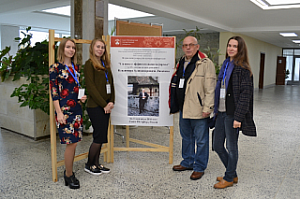A team of TSU Laboratory for Physics of High-Strength Crystals has developed a new high-strength material based on iron. Its use will improve the quality of actuating mechanisms and sensors for mechanical engineering, aerospace, and other industries. The results of the study were presented at the international conference Alloys with Shape Memory Effect (St. Petersburg).
- The most widely known and used alloy with shape memory effect is nickel titanium. In our laboratory we were the first who created monocrystals of iron-based alloys, especially iron-nickel-cobalt-aluminum, the fifth element may be titanium, niobium, or tantalum. These alloys can compete with nickel titanium, - said Yury Chumlyakov, the Head of Laboratory.
In particular, iron-based alloys created at TSU have greater reversibility than nickel titanium, that is, their ability to recover itself after deformation is high. The alloys based on iron have a reversible change in shape about 15%, and nickel titanium alloys have about 10%. Due to this, the sensors and actuators of the iron-based alloys will work effectively as mechanisms which driven by them. This result was achieved through a special heat treatment - a technology, on which scientists of the laboratory have already obtained a patent.
The iron-based alloys have high strength. This aspect is important for practical use in devices that must withstand high external loads, such as in aerospace and engineering industries. The laboratory employees emphasized that the sensors and executive devices constructed from the new iron-based alloy will not only stronger but also cheaper products from on nickel titanium. Thus, the use of iron-based alloys can reduce the cost of production of household equipment, fire alarm sensors, connecting elements for the aerospace and automotive engineering, and others.
Scientists have developed a new high-strength material based on iron in the framework of the project Mechanisms of Phase and Structural Transformations in High-Strength Crystals of Iron and Nickel-Titanium Based Alloys with Conventional and Magnetic Shape Memory Effect, which is supported by a grant from the Russian Science Foundation in the amount of 51 mln rubles. The laboratory plans to continue the study of iron-based alloys.
TSU Laboratory for Physics of High-Strength Crystals under the leadership of Professor Yury Chumlyakov is one of the leaders in the development of the new materials. Here it has been developed a unique technology for creating monocrystals based on iron, cobalt, and nickel alloy of titanium, having a thermoelastic martensitic transformation, and nanocomposites on their basis, the structure and properties of which can be controlled. The laboratory is part of TSU’s StrAU Smart Materials and Technologies and collaborates with 20 countries.
TSU Laboratory for Physics of High-Strength Crystals at the international conference in St. Petersburg was represented by 3 Doctors of Physical and Mathematical Sciences (Yury Chumlyakov, Irina Kireeva, and Elena Panchenko), 2 PhDs and 3 graduate students. Special attention was given to an invited report by Professor Yury Chumlyakov. Scientists have reported on their developments in the creation high-strength monocrystals based on cobalt, nickel, iron, and titanium. Postgraduate students Eftifeeva Anna and Anton Tagiltsev were awarded diplomas for the best papers of young scientists.

